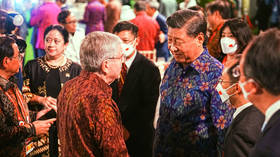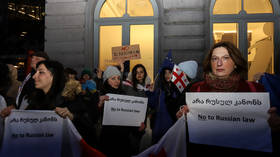Timofey Bordachev: Why the West’s standoff with Russia and China is a big opportunity for the world’s second-tier powers

We can argue all we like about how the new international order will look but one thing is clear: it will not resemble any previous incarnation. History does not tend to repeat itself, which always means that recourse to historical analogies remains a sign of intellectual unpreparedness for contemporary events.
It’s the same today – any attempt to find a firm basis for comparison between the past and the processes and phenomena of international life that we currently observe is inevitably confronted with convincing arguments as to why this or that analogy is not appropriate. It was even difficult in the past, when the main issue was the changing power capabilities of a relatively small group of states. It is all the more impossible to find examples now, in a completely changed international context. And it is very likely that paying attention to the context will help us to better visualize the contours of the order that will emerge in a few years, if not over decades.
The most important revelation of the first year of the open military-political confrontation between Russia and the West is that international politics is being shaped by a significant group of states that do not seek to align themselves with the banners of the opposing sides. Moreover, they are pursuing their own active policies, which are not entirely comfortable for either Russia or its adversaries. On the other hand, since Moscow is not the initiator of tensions with the United States and its allies and does not pursue an aggressive policy towards them, the restrained behavior of most of the world’s countries becomes a factor that significantly influences the situation in favor of Russian interests. Except for a few powers, the majority of the world’s states cannot directly support Russia either. As a leading Chinese expert on international relations rightly pointed out in an interview, Russia is going through a conflict with the entire West “practically alone.”
However, regardless of the extent to which the behavior of the so-called world majority conforms to Russian or Western expectations, the very fact of its involvement in international affairs has become quite clear. The same is true of the lack of intention on the part of this multitude of countries to align themselves with the US, China or Russia in a future great-power confrontation. But this does not negate the need to understand the motives and driving factors of such a significant and influential group of states – a structural feature of contemporary international politics.
There may be considerable scope for theoretical and applied reasoning in this regard. The importance of this area of intellectual inquiry is linked to the fact that the behavior of the majority is the most important factor among those that will determine the structure of the future international order. The stances of the great powers, especially the nuclear states, is more or less clear: they will ensure their own security by relying on their unique military capabilities. In addition, the closeness of Russia and China and their lack of objective clashes of interest also provide a degree of certainty. The same goes for the United States and its European allies: with dwindling resources, they will be on the defensive about all their post-World War II privileges. But we cannot say the same about the world majority. This is why, incidentally, many respected colleagues are keen to base their assessments on the one relatively stable factor that represents a coherent community of Western interests and values.
However, it remains unclear to us how this large group of countries will behave in relation to the nature of the particular conflict on which they are expected to take a position. The lack of an answer to this question means that we continue to have to make very shaky assumptions. We are currently dealing with a confrontation in which the opposing sides are comparable military powers – Russia and the United States, although the latter is acting through intermediaries. Russia is also a major player in the global markets for energy, food and a range of other commodities for which demand is stable. Standing behind Russia is China, which, like Moscow, is a permanent member of the UN Security Council and wields considerable influence in the world.
In other words, we have a unique example of a struggle in which the forces of the adversaries are roughly comparable, although the superiority of the West, in many areas, is considerable. And we do not know how the countries of the world majority would behave if the US and Europe launched an offensive against a weaker opponent – Iran or another country of comparable size, for example. It is therefore impossible to speculate on the extent to which the assertiveness of those countries which ignore US orders now would have manifested itself in a different situation. This could be important in the future, as new conflicts involving a major nuclear power cannot be ruled out.
In general, it is difficult to determine how much of the behavior of most countries is restrained by their own capabilities. It is generally accepted that this has become the main determinant of the actions of a wide range of states, from the wealthy monarchies of the Gulf to those of Southeast Asia. But there is no denying that their degree of dependence on the infrastructure of the outgoing liberal world order, led by the United States, remains very high. Undoubtedly, the dramatic events of 2022 have set in motion the aspirations of many medium and small powers to gain practical tools for their autonomy. But they still have a long way to go.
Perhaps this is why the West believes that, if it succeeds against its main adversaries, Russia and China, it can easily regain control over everyone else. And until the comparative individual capabilities of small and medium-sized states become serious enough to allow them to be truly self-reliant, Western self-confidence will continue to push the US and Western Europe into confrontational behavior.
At the moment, the majority of the world’s countries are seeking short-term gains from the general turmoil caused by the struggle between the great powers. But the extent to which such tactical gains can form the basis of a long-term strategy is unknown.
Any resultant chaos will inevitably be replaced by a more or less systematic engagement between the main adversaries. And we do not know how countries like Turkey, Saudi Arabia, Vietnam or Pakistan will be able to defend their independence when the international environment is less conducive to it. Some of them may indeed be motivated by the values that Moscow and Beijing are now proclaiming: equal rights, equal benefits and the authority of international law for all. But it cannot be ruled out that the rising powers will find it harder to defend these gains as the world becomes increasingly divided into major warring regions.
That said, perhaps the great powers will emerge from the acute phase of their confrontation so weakened that they will not be able to dictate their will to the others.















